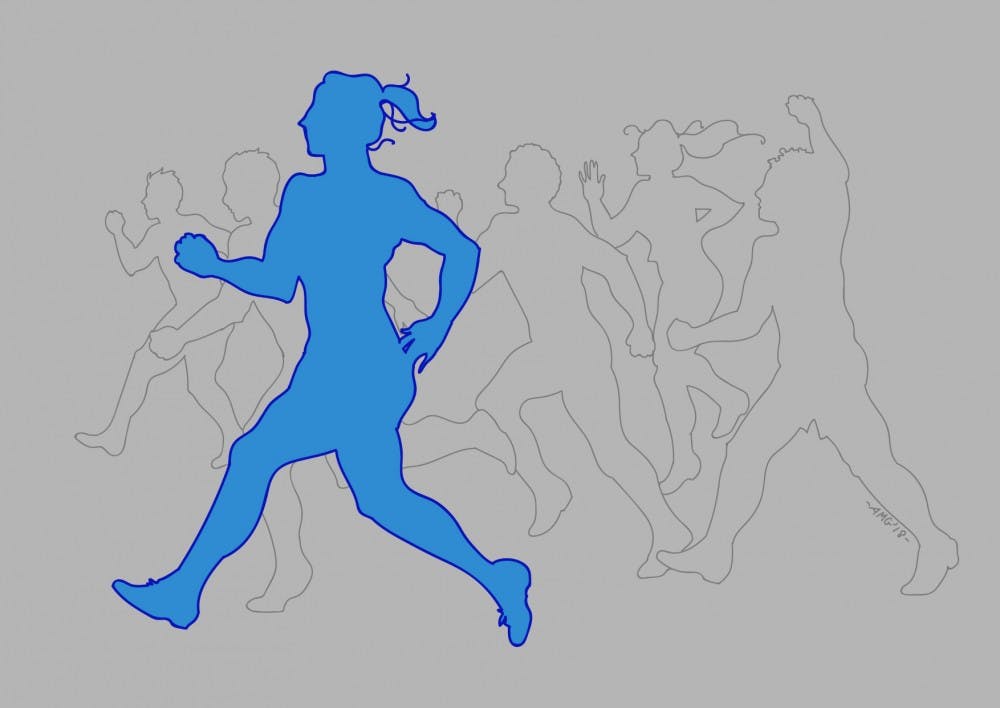On Sunday November 18, over 30,000 runners hit the Philly streets for the Philadelphia Marathon. Think 26.2 miles is impossible? This week Street spoke to Penn students running full and half marathons to discuss their training plans, motivation, and pre–race rituals. Here’s what they advised:
Start small, stay consistent — build up to it.
Consistency is key. Take it slow and build up your endurance. There are a ton of different training plans out there, but they usually consist of one long run, one day of cross–training (swimming/cycling/walking), and three to four days of shorter fast runs.
For example, this first–time marathon program advises gradually increasing your weekly long–run from six to 20 miles over the course of 13 weeks. What about the last six miles? “At that point you just want to finish,” says Louise Tanski (C '19). On the race day the adrenaline and rush of the group run is often enough to propel runners to the finish line.
Last spring, Tanski, a former member of Women’s Crew Team, suffered a bad case of mono that went undiagnosed for months. Louise signed up for the marathon as a personal challenge, to prove she was fully recovered.
“I had never been injured or out of shape. After mono I couldn’t exercise for more than 30 minutes without feeling exhausted,” she says. She started building up her training over the summer, using heart rate tracking to keep herself motivated. “I got serious about running about eight weeks ago, eventually building up to 20 miles.”
For some runners, they stay motivated with an aim to beat a specific time. “My goal is to run [the marathon] in under three hours and five minutes,” says Wes Wendell (C '21), a member of Penn Run Club.
To meet this ambitious goal, Wendell runs 44 to 55 miles per week—one long run over 15 miles per week and four shorter runs at six to 11 miles. Like most runners Wes is tapering off his training in the weeks leading up to the race.
“I’m taking two days off this week and doing much shorter distances,” he says. Tapering gives your body time to rest and recover before the final push of the marathon.
Be mindful of injuries.
Listen to your body. Long distance running is high impact, repetitive stress on your muscles and joints. If left untreated, minor injuries can worsen and hinder training.
“I got injured a lot the first couple weeks of training. I had to stop and strength train my legs before increasing my mileage,” says Sal Villatoro (C '19). As a pre–med student with a job, Villatoro finds time to sneak in long runs between studying and working. He stresses the importance of listening to your body during training.
“A month ago I got planters fasciitis—or runner’s foot—and had to take time off,” he says. Runner’s foot, or planters fasciitis, is an inflammation of connective tissue in the heel that is particularly common among runners, but can be treated with rest. However, if left untreated, it can develop into stress tears in the muscle. Wes is also careful to avoid injury, and says, “In August I was getting the beginnings of plantar fasciitis and took two weeks off.”
Stress fractures, or small cracks and bruising within the bone are also common injuries caused by overuse and repetitive training. Athletes with lower body masses are more prone to stress fractures and take longer to heal.
Louise is mindful of what she eats and makes sure to maintain her weight throughout training. “I’ve had stress fractures in the past—in my foot and in my ribs. They usually happen when I drop weight too quickly,” she says.
Fuel properly.
Eating properly before, during, and after running is essential for peak performance.
“On the morning of my long runs, I’ll wake up an hour early and eat eggs or oatmeal beforehand,” says Louise “Otherwise by mile 10 I’ll be dead.”
Your body can only store so much glycogen, which is its primary source of fuel during a run. Wes says, “I’ve been practicing eating during my runs.” Consuming small amounts of carbohydrates during the run, whether in the form of energy chews or gels, can prevent runners from “hitting the wall” or experiencing intense muscle fatigue.
Take time to recover.
The days immediately following the race are critical. Your body has gone through the toughest test of endurance and your immune system is particularly vulnerable. Take it easy.
“Foam roll, take hot baths, drink a ton of Gatorade, treat myself to McDonald’s,” advises John Casey (W '21) as he describes his post–race recovery ritual.
John took 10 days off after the Baltimore Marathon in October and waited a full three weeks before going back to intensive training. Recovery time can vary widely person to person; however, most people need at least a week before exercising again.
So if you’re considering running a marathon or even a more manageable half marathon, now’s the time to start training. Just be sure to arm yourself with information first before you hit the running trails. Your time spent training will help you conquer those 26 miles, but you won’t get that far without listening to your body and get plenty of rest.
Upcoming Half and Full Marathons
NYC Big Apple Half Marathon: December 9, 2019
Love Run Philadelphia Half Marathon: March 31, 2019
Rock n Roll Marathon Washington DC: March 9, 2019

